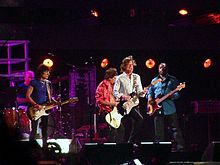Pop music
Identifying factors of pop music usually include repeated choruses and hooks, short to medium-length songs written in a basic format (often the verse–chorus structure), and rhythms or tempos that can be easily danced to.[18] According to British musicologist Simon Frith, pop music is produced "as a matter of enterprise not art", and is "designed to appeal to everyone" but "doesn't come from any particular place or mark off any particular taste".Frith adds that it is "not driven by any significant ambition except profit and commercial reward [...] and, in musical terms, it is essentially conservative".It is, "provided from on high (by record companies, radio programmers, and concert promoters) rather than being made from below (...) Pop is not a do-it-yourself music but is professionally produced and packaged".[3] According to Frith, characteristics of pop music include an aim of appealing to a general audience, rather than to a particular sub-culture or ideology, and an emphasis on craftsmanship rather than formal "artistic" qualities.[28] The lyrics of modern pop songs typically focus on simple themes – often love and romantic relationships – although there are notable exceptions.[3] During the mid-1960s, pop music made repeated forays into new sounds, styles, and techniques that inspired public discourse among its listeners."[36] The latter half of the 20th century included a large-scale trend in American culture in which the boundaries between art and pop music were increasingly blurred.[40] Scientific American's John Matson reported that this "seems to support the popular anecdotal observation that pop music of yore was "better", or at least more varied, than today's top-40 stuff".[40] In the 1960s, the majority of mainstream pop music fell in two categories: guitar, drum and bass groups or singers backed by a traditional orchestra.[41] Since early in the decade, it was common for pop producers, songwriters, and engineers to freely experiment with musical form, orchestration, unnatural reverb, and other sound effects.[42] At the same time, pop music on radio and in both American and British film moved away from refined Tin Pan Alley to more eccentric songwriting and incorporated reverb-drenched electric guitar, symphonic strings, and horns played by groups of properly arranged and rehearsed studio musicians.[45] Assisted by the mid-1960s economic boom, record labels began investing in artists, giving them the freedom to experiment, and offering them limited control over their content and marketing.[59] Popular artists were Avril Lavigne, Justin Timberlake, NSYNC, Christina Aguilera, Destiny's Child, and Britney Spears.This change was epitomized in Spears' highly influential 2007 album Blackout, which under the influence of producer Danja, mixed the sounds of EDM, avant-funk, R&B, dance music, and hip hop.






Popular musicPop music (disambiguation)Pop SongTraditional poprock and rollNew wavehyperpopAlternative popart popBrill Buildingbubblegumdance-popoperatic poporchestral popschlagersophisti-popsunshine popsynth-popteen popwonky popcomplete listBaroque popcountry popcontemporary R&Bcowboy popdancehall popelectropopemo popfolk-pophypnagogic popindie poppop-punkpop rappop-soulambient poppop rockpop metalpower poppsychedelic popspace age popworldbeatAustriaBrazilColombiaFranceHong KongIndonesiaKazakhstanMalaysiaMexicoMiddle EastMoroccoNetherlandPakistanPhilippinesRussiaScandinaviaSouth AmericaSouth KoreaSri LankaSwedenTaiwanThailandTurkeyUnited KingdomUnited StatesVietnamWestern EuropeAfrican popAfro fusionAvant-popexperimental popNew Poppop music automationpoptimismrock musicverse–chorus structurecountryart musicrecord chartsDavid Hatchsingles chartsclassicalnovelty songshillbilly musicthe Rolling StonesThe New Grove Dictionary of Music and MusiciansBritainThe Beatlesbeat musicauthenticitySimon Frithenterprisedo-it-yourselfYou've Lost That Lovin' Feelin'Nick LoganBob Woffindeneasy listeningprogressive developmentsAmr DiabAfricarhythmic elementstructurethirty-two-bar formmelodieschorusharmonicallyHarmonychord progressionstonalitybarbershop quartet-style harmonyblues scalecircle of fifthsdominantfunctionBillboardBing Crosbymicrophonetransistor radiosMichael JacksonMadonnaMulti-track recordingdigital samplingMusic criticSimon ReynoldsBritish Invasion